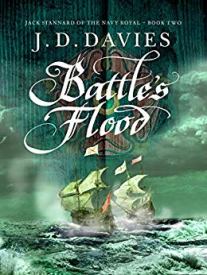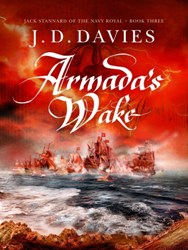 Pirates and Privateers Pirates and Privateers
The History of Maritime
Piracy
Cindy Vallar, Editor
& Reviewer
P.O. Box 425,
Keller, TX 76244-0425
    
Books for Adults ~ Nautical Fiction
The
Mountain of Gold
Destiny's Tide
Battle's Flood
Armada's Wake
Sailor of
Liberty
Tyranny's
Bloody Standard
The Cursed
Shore

The Mountain of Gold
By J. D. Davies
Houghton Mifflin Harcourt, January 2012, print ISBN
978-0-547-58099-9, US $25.00
e-book ISBN 978-0-547-58102-6, US $25.00
    
Captain Matthew Quinton
would just as soon hang his prisoner, Omar
Ibrahim of Oran, for the pirate and
traitor that he is. But the Barbary
corsair, who was taken from his home in
Baltimore, Ireland by Barbary corsairs and
joined them rather than become a slave,
dangles information about a mountain of
gold that Quinton can’t ignore. Against
his better judgment, he orders his ship
back to England where King Charles II
arranges for Quinton, with the help of
Ibrahim, to lead an expedition to Gambia
to find this treasure. Matthew is certain
the tale is nothing but a hoax, but he
dares not go against His Majesty’s orders.
While waiting for his new ship, Matthew
must deal with a more personal problem. He
is next in line to inherit the earldom of
Ravensden from his brother, Charles, who’s
slated to wed a mysterious woman who has
been wed twice before. Matthew’s wife and
uncle are certain Lady de Vaux intends to
murder Charles, and begin an inquiry into
her past in hopes of turning up evidence
that she killed her previous husbands.
Matthew is also against the marriage, but
since it has the king’s blessing, there is
little he can do to prevent it.
Before Matthew departs for Gambia, he
learns that some members of the government
are determined to make certain the
treasure remains buried. An attempt is
made on his life, then an unexplained fire
threatens to destroy his ship. Nor are
Matthew and Omar the only ones seeking the
gold. Soon after they arrive in Africa, an
emissary of Louis XIV of France attempts
to kidnap and torture Omar into revealing
the gold’s location while thwarting
Matthew and his men from achieving their
objective. To further complicate matters
there’s Omar himself; how can one really
trust a pirate and traitor?
Although this is the second in the Matthew
Quinton series, The Mountain of Gold
works just as well as a stand-alone tale.
Davies spins a complex web of intrigue and
adventure in which readers soon find
themselves aboard a ship of the Royal
Navy, or staying in a home that is greatly
in need of repair, or trekking across the
desert under a broiling sun. The first
paragraph grabs your attention and, once
ensnared, you won’t resurface until the
story ends. By then it is too late – the
author has captured your interest to such
a degree that you can’t wait for the
continuation of Matthew Quinton’s
adventures. What is particularly
refreshing, at least from my viewpoint, is
that Davies opted to set his story in the
Cavalier period, rather than the more
popular Age of Nelson. He deftly brings to
life this bygone era while vividly
recreating the experience of sailors in
the Royal Navy and the dangers and wonders
these intrepid explorers and fighters
encountered.
Review Copyright ©2011 Cindy Vallar


Destiny’s Tide
By J. D. Davies
Canelo, 2019, e-book ISBN 978-1788632300, US
$2.99
Once
a vibrant town, Dunwich’s importance dwindles
because of Mother Nature and because of its
rivalries with other Suffolk towns. Jack and
his father, Peter Stannard, are English
traders whose ships make them important
merchants in Dunwich. Growing up in Peter’s
shadow is fraught with peril; Peter is abusive
and Jack never measures up to his deceased
older brother. His father’s penchant for drink
and strange affliction only worsens the abuse
that Jack endures.
Jack has high hopes to reclaim his town’s
stature by answering King Henry’s summons to
first teach the Scots a lesson for reneging on
a promise to wed their infant queen Mary to
Prince Edward and then attack France. Jack
commands the Suffolk contingent of ships, much
to the chagrin of Raker of Southwold and
Maddox of Walberswick. The rivalry between the
three towns is an ancient one, but there is
bad blood between Raker and Peter. Jack
doesn’t understand why, but he definitely
experiences the results. No sooner do they
arrive at the gathering spot for the king’s
ships than he is arrested. When he finally
faces his accusers, he also learns the serious
charges they have brought against him.
Once
a soldier, Thomas Ryman sets aside his sword
to take holy orders. After a decade with the
Grey Friars of Dunwich, he and his fellow
brothers are turned out of their home upon the
king’s dissolution of the Catholic Church and
its monasteries. Having last fought the Scots
at Flodden Field, he takes up his sword once
again and sails with Jack, his former student.
Thomas’s familiarity with soldiering and his
past contacts provide him with a means of
rescuing Jack after his arrest.
This first book in the Jack Stannard of the
Navy Royal series occurs between 1537 through
1547, although the principal portion of the
story takes place from April 1544 through July
1545. It is a mix of life in England during
perilous times and battles at sea in which
ingenuity and fortitude play equal roles.
Davies’s vivid and poignant portrayal of the
capture of the Scottish warship Unicorn,
the rescue of a Genoese captain, and the
sinking of the Mary Rose keeps readers
on the edges of their seats while holding
their breaths. Equally compelling are scenes
involving the ongoing religious changes that
begin with the dissolution and climax with the
partial destruction of a Dunwich church. Destiny’s
Tide is also a tale of secrets,
jealousy, and betrayal. Since most naval
stories focus on later historical periods, it
is refreshing to be to an earlier era when a
temporary navy safeguards the realm and we see
it begin to evolve into the royal navy we are
familiar with today.
Review Copyright ©2019 Cindy
Vallar


Battle’s Flood
By J. D. Davies
Canelo, 2019, e-book ISBN 978-1788632317, US
$5.99 / UK £2.99
    
England
in 1555 differs from the one in
which Jack Stannard fought the Scots
and witnessed the death of his
friend aboard the Mary Rose.
Henry VIII is dead; his daughter,
Mary, sits upon the throne and
expects her first child. Her husband
is King Philip of Spain, but in
spite of the peace between both
countries, he has no desire to allow
his wife’s people to venture into
realms he deems the total domain of
Spain, namely the New World and
Africa. Not all Englishmen agree
with this, chief among them being
the Hawkins.
It is also a time
when Catholicism once again holds
sway, much to the delight of Jack
and his daughter, Meg. Love
blossoms between her and a young
Spaniard whose father is friends
with hers. Hope and prosperity
give rise to great expectations,
but that which is today isn’t
necessarily true on the morrow.
The passing of twelve
years brings many such changes.
The Virgin Queen rules England and
has restored the faith of her
father to the land, much to Meg’s
chagrin. She holds out hope that
it is a temporary aberration, one
that will change once again when
Mary Queen of Scots succeeds her
cousin Elizabeth. Jack, on the
other hand, and his eldest son,
Tom, are involved in the business
of smuggling arms to France, where
Protestant Huguenots are
stockpiling arms for the day when
the Catholic monarchy allies with
Spain to stamp out the heretics.
While Tom has been raised mostly
in the Protestant church, his
father retains many Catholic
tendencies, and it is those that
come to the attention of Francis
Walsingham, the queen’s spymaster.
John Hawkins’s new
expedition to Guinea and possibly
the Caribbean is purported to be a
trading venture into Spanish
domains, but it has an ulterior
purpose known only to a few.
Walsingham wants Jack to accompany
the expedition. Although
hostilities with Spain are on the
distant horizon, England is
unprepared to wage war at this
time. Therefore, Jack must do
whatever he can to keep Hawkins
from breaking the fragile peace
between the two countries, and to
keep a detailed record of
everything that happens. Such
unfamiliar waters to Jack and Tom
require them to hire a skilled,
black Portuguese, who is somewhat
abrasive at times. The voyage gets
off to a rocky start; foreign
ships entering the port fail to
salute and a tavern brawl creates
animus between Tom and Francis
Drake, who one day vows to get
revenge. Venturing to strange
lands with unfamiliar customs and
unknown dangers adds to the perils
Jack and Tom face.
Such
a journey means a lengthy
separation from family and
friends, so Jack puts Meg in
charge of the family business. She
tries to warn him that her
stepmother is up to no good, but
time prevents him from heeding the
warning. Having despised and
distrusted her stepmother from the
moment they first met, Meg slowly
unravels the intrigue and
discovers that Jennet is in league
with Jack’s most hated enemy. To
thwart her stepmother, Meg devises
a plan of her own, one that will
protect the business, her father,
and the secret she guards.
Battle’s Flood
is the second title in the Jack
Stannard of the Navy Royal
trilogy. While the prologue takes
place in 1555, the majority of the
story takes place between 1567 and
1569. The backdrop for the story
is Hawkins’s third voyage to
collect slaves in Africa and sell
them to Spanish colonists in the
New World. That one event did not
occur in a void, as Davies shows
as he deftly weaves the tumultuous
European history into this tale in
ways that make it easy to
understand the intricacies of
trying to survive in a world
verging on war. He drops you into
the midst of a battle or a storm
at sea with just enough
description that then compels your
imagination to vividly fill-in the
details. Peaceful interludes are
woven into engrossing and
sometimes nail-biting action, rife
with mutiny, poisoned arrows,
tribal warfare, the slave trade,
smuggling, cannibalism, love lost,
betrayal, enmity, feuds, scheming,
regrets, and much more. Equally
compelling is his historical note,
not only because he provides the
history behind the fiction but
also because he addresses
inconvenient truths, thorny
issues, and his treatment of these
in the book. While history books
discuss these events and recount
the unfortunate circumstances that
result in the abandonment of so
many, those accounts are often
mere words on a page. In Battle’s
Flood, Davies brings to life
the infamous and the famous, and
transports you back to the 16th
century in a way that makes you
feel as if you are there.
Review
Copyright ©2020
Cindy Vallar


Armada’s Wake
By J. D. Davies
Canelo, 2020, e-book ISBN 978-1788632324, US
$5.99 / UK £3.99
    
Twenty
years have passed since the
tragic expedition to the
Caribbean that abandoned Jack
Stannard and other Englishmen to
the whims of the Spanish. Now,
all of England fearfully awaits
word of the arrival of King
Philip’s Armada. Peter Stannard,
one of Jack’s grandsons, has the
honor of delivering that fateful
news during the middle of a
theater performance. He has no
intention of fighting, but his
brothers and father are already
on ships of the Navy Royal,
determined to stop the invaders.
Disquiet and
disappointment swirl within
John Stannard, who finds
himself aboard Sir Francis
Drake’s Revenge. Being
in the Navy Royal is where he
wants to be, but not serving
as the deputy purser. He’s an
accomplished sailor and
fighter, but the vice admiral
bestows this job upon him
because he possesses a rare
skill: the ability to do math.
Nor does it help that one of
the gentleman volunteers, a
man named Nicholas Fitzranulf,
has taken an instant dislike
of John. Time and again they
butt heads, until John finally
discovers the arrogant
popinjay engaged in an
activity for which the
punishment might well mean
death and dishonor. While
Fitzranulf takes the out John
offers him, their mutual
dislike only worsens.
Meanwhile his
father, Tom, and oldest
brother, Adam, are with the
Narrow Seas fleet, England’s
last hope should the rest of
the Navy Royal fail to stop
Spain’s Armada. While Tom’s
lifeblood is the sea, he
hasn’t a clue as to why Adam
wished to join his crew.
Adam’s religious zeal makes
the men uneasy and only
worsens when he witnesses a
forbidden act. In fact, this
knowledge tips the balance of
Adam’s sanity and only Tom’s
standing within the fleet and
the community allow him to
rescue Adam. It isn’t until
after the admiral asks Tom to
make a sacrifice for the good
of the fleet that he discovers
the price asked is far greater
than he initially thinks.
Peter’s
determination to remain
outside the fight proves
futile. Besotted with a
scullery maid, he tangles with
the bishop’s steward, who has
been taking liberties in spite
of her protests. In the
aftermath, Peter has no other
option than to elude pursuit
by assuming another identity
and enlisting in the militia.
His stage experience proves
handy not only as a soldier
but also in thwarting the law.
With Spanish
hysteria and fear rousing the
countryside, Meg de Andrade
(nee Stannard) is arrested on
charges of witchcraft. The
face of her prosecutor might
be the justice of the peace,
but Meg knows her true enemy
is her half-sister. Ill blood
has existed between them since
her father married Mary’s
mother, and with brother Tom
and her nephews at sea, there
is no one to help her escape
this predicament. She must
keep her wits about her, but
fears that Mary’s enlistment
of the family’s nemesis may
tip the balance and result in
Meg being hanged.
Known as “the man
who will live forever,” Juan
Estandar has longed dreamed of
returning to his family, but
never thought to see England
again. But his homeland lies
not far from the Girona,
the Spanish ship that is both
his home and his prison. He
has been a galley slave for
longer than he wishes to
remember. Although Juan
practices the true faith, his
past association with Spain’s
heretical enemies, the pirates
Drake and Hawkins, guarantee
that he will burn in the fires
of hell according to Fra
Gordillo. One day, the
malevolent priest goes too far
and Juan lashes out. The
consequences are dire, but
fail to quench his dream.
Have you ever
read a book that pulls you
deeper and deeper into the
story, that makes you want to
toss aside all obligations and
just read? Armada’s Wake
is one such story. It is the
last entry in the Jack
Stannard of the Navy Royal
trilogy and, while it
encompasses only a brief span
of time in July 1588, it
recounts events in the lives
of three generations and is,
by far, the best of the three
books. The depth and breadth
of the characters draw readers
into the midst of the 16th
century, whether it be at sea
or in England or Ireland.
Davies weaves a web of many
threads that are intricately
spun together to provide a
riveting tale that allows
readers to experience a wide
gamut of emotions. This is
historical adventure at its
finest and the portrayal from
both sides of the battle makes
for a poignant and memorable
account that vividly portrays
the perils of the Spanish
Armada’s invasion of England.
Review
Copyright ©2020
Cindy Vallar

 Sailor of
Liberty
Sailor of
Liberty
by J. D. Davies
Canelo, 2023, e-book ISBN 978-1804360866,
US $5.99 / UK £3.99
Also available in print formats
    
The voyage is
to be sedate, a quiet sail
into Saint-Malo and
Philippe Kermorvant will
step ashore with little
fanfare. Fate decrees
otherwise. The enemy
emerges from the fog and
unleashes a devastating
volley that kills the
captain. His matelots
persuade Philippe to
rescue them from the
onslaught. He agrees and
uses his experience
commanding American and
Russian ships to trick the
enemy long enough to get
away.
It is Year
Two of the French
Republic, although his
many friends know the
time as 1793. Some think
his dream folly, but it
is a pursuit he cannot
give up. It gives his
life purpose, something
he lost when grief
consumed him. Surely,
the Republicans will
grant his request,
especially with the many
letters of
recommendation that he
carries. Especially
since his father was
Verité, a hero, a
legend, a
forward-thinking
Frenchman who espoused
freedom long before the
citizenry rose up
against the monarchy.
But nothing is
guaranteed, particularly
when the Committee of
Public Safety dares even
to behead Citizen Louis
Capet, the former king
of France. The same fate
may become Philippe’s, a
fact he understands
since he is the Vicomte
de Saint-Victor.
That
possibility becomes all
too real when someone
close to Philippe
denounces him as a
traitor to the Republic
and a mob comes to
arrest him. Although
given a chance to escape
his prison, he prefers
to meet Madame
Guillotine. This
decision, combined with
his betrayer being
denounced with
irrefutable evidence,
leads to Philippe’s
freedom and the granting
of his dream. He will
captain Le Zéphyr,
a 32-gun frigate manned
by several hundred men.
An easy task for someone
with his experience, n’est-ce
pas?
Perhaps
not. His
second-in-command
denounced his
predecessor to the
Committee and expects to
be given command
himself. The crew is a
mix of able seamen and
landsmen, but each
believes he has the
right to question any
order the captain gives.
The representative of
the Committee neither
likes nor trusts
Philippe. He must patrol
regions of France where
loyalists eagerly await
a British invasion in
support of their cause.
Mutiny ripples through
French warships, while
English warships
blockade the coast. It
is only a matter of time
before one, or more, of
these enemies attempt to
thwart Philippe.
Philippe
may look through
rose-colored glasses,
but he does understand
what’s happening in
France. He is a flawed
hero in this regard, but
this makes him real and
results in the truths he
witnesses being all the
more horrific. Many
stories that depict the
French Revolution and
Napoleonic Era unfold
from a British
perspective, which makes
this new series fresh
and unique because
readers experience
events from the French
point of view. The
villains are dastardly
and deserve our
loathing, but Davies
portrays them as
products of their time
and illustrates how
tenuous a path Philippe
must weave to navigate
such treacherous waters.
As always, Davies’s
knowledge of history and
the maritime world are
seamlessly woven into
the story, and he
vividly and
realistically portrays
the brutality of war and
revolution. This first
entry in The Philippe
Kermorvant Thrillers is
a bewitching tale in and
of itself, but the
unexpected twist at the
end promises many more
provocative tales to
come.
Review
Copyright ©2023 Cindy Vallar


Tyranny’s
Bloody Standard
by J. D. Davies
Canelo, 2023, ISBN
9781804360903, US
$5.99 / UK £3.99
Also available in
other formats
In
February 1794,
Philippe Kermorvant
and some of his men
escape from the
English prison hulk
where they are
imprisoned with the
help of an American.
Once back on French
soil, Philippe is
given command of Le
Torrington,
whose slowness earns
the thirty-eight-gun
ship the nickname of
English Tortoise. It
takes luck and
ingenuity to elude a
British warship
hunting them, and
while they succeed,
they and the rest of
the French fleet end
up blockaded within
the port of Île
Sainte-Marguerite.
Orders
arrive summoning
Philippe away from
his ship to a
rendezvous at an
inland tavern.
There, he meets with
a general who
advises him that he
is to accompany an
emissary to Corsica.
The purpose is to
gain permission for
the French navy to
use the island as
their base of
operation in the
Mediterranean, and
the man Philippe is
to meet, General
Leandre, has
personally requested
him. Equally
surprising is the
emissary, a young
woman who seems an
odd choice to carry
out this mission.
What perplexes
Philippe is why he
has been tasked with
this assignment and
why would anyone
want the bones of
Christopher
Columbus?
Meanwhile,
back in England,
spymaster Lord
Wilden is perturbed
that his
French-American
cousin, Philippe
Kermorvant refused
his overture to spy
for the British. A
mob rioting for fair
wages attacks
Wilden’s coach and
kills his driver. He
blames the French
for the attack
because their
Jacobin ideas are
infecting
Englishmen. He vows
to make the enemy
pay, and to that
end, he sets in
motion a collision
between his cousin
and the man who slew
Philippe’s wife and
son.
Thibauld
de la Porte is a
young aspirant aboard
Philippe’s ship. He
comes from a family
whose men have long
fought in the army,
but he chooses to
follow a different
path and enlisted in
the navy. He pens
letters to convince
his father that he
has made the right
decision. Initially,
he is pleased to be
aboard Le
Torrington,
but little incidents
make him think that
perhaps his
enigmatic captain
may be the British
mole within the Marine
Nationale.
When an incident
involving the
Knights of Saint
John on Malta
embarrasses the
young midshipman, he
also blames the
captain for his
disgrace and wants
vengeance.
Tyranny’s
Bloody Standard
focuses on a
little-known period
of history when King
George III of
Britain also ruled
Corsica. Some
readers may find
there’s a bit too
much rehashing of
past events in this
second book in the
Philippe Kermorvant
Thrillers, but
Davies spins a tale
of intrigue,
superstition,
murder, and
vendettas that
introduces readers
to a young Horatio
Nelson and Napoleon
Bonaparte. (Neither
man is mentioned by
name, but their
descriptions leave
little doubt as to
each man’s
identity.) A fair
portion of this tale
takes place on land
rather than at sea,
which is inevitable
since it unfolds
principally from a
French perspective
and the French fleet
spends much of the
war with England
penned up in port
because of the Royal
Navy’s blockade. A
riveting duel at sea
does take place
between Le
Torrington and
an Italian warship
during a gale that
keeps readers
guessing and on the
edge of their seats.
Equally compelling
are witnessing the
psychological effect
cowardly behavior
has on someone and
the inability to
come to the aid of a
merchant vessel
attacked by Algerine
corsairs because
France and Algiers
are at peace.
Review
Copyright ©2023 Cindy Vallar


The Cursed Shore
by J. D. Davies
Canelo, 2024, ISBN 9781804366110, US
$ 6.49 / UK £4.99
Also available in other formats
    
The summer of 1795 finds English
soldiers disembarking at Quiberon
Bay in Brittany. The expedition –
a joint venture with French
royalists – is an attempt to
regain control of France and place
the imprisoned boy king Louis XVII
on the throne. Accompanying the
expeditionary force is Lord Edward
“Ned” Wilden, who is also a lord
of the Admiralty and less widely
known, a spymaster for the prime
minister. Neither believes this
venture will be successful. There
is too much infighting between the
royalist factions. The emigrés
look upon the Chouans and
Vendéeans with disdain, even
though these men of varying social
ranks have remained in France to
fight the republicans, while the
former fled their homeland. Ned’s
job is to keep peace among these
factions, a thankless job that he
would far rather be someone
else’s.
Leonore Kermorvant, the
widow of a royalist martyr whom
she betrayed to the republicans,
questions where she stands with
her brother-in-law. There is an
attraction between the two, but
there also is an unbridgeable gulf
that neither seems willing to
cross. Perhaps this is one reason
she dares to violate all that she
believes in to provide succor to a
wounded royalist colonel.
Philippe Kermorvant,
Vicomte de Saint-Victor, is livid
when he discovers the intruder in
his home, but the colonel’s
contingency plans find Philippe
the prisoner instead of the
royalist. It is only Leonore who
can save him, but her actions have
opened a wider chasm and once
free, he immediately goes to sea.
Since his requests for a new ship
fall on deaf ears within the Marine
Nationale, he grudgingly
accepts a privateer’s commission
from a Swiss merchant and his son.
Philippe has misgivings but needs
the funds to repair his chateau.
With a comrade from his old crew
joining in this voyage, he sets
aside that niggling worry. Only to
have it roar back to life when
secret orders are revealed after
they set sail.
Davies has a knack for
taking disparate threads and
twining them together to create a
riveting tale that is adroitly
brought together in unexpected
ways that eventually make perfect
sense. At the same time, the
characters and the situations they
face elicit emotions that readers
readily understand and identify
with. Normally, Lord Wilden is
portrayed more as the villain in
the Philippe Kermorvant Thrillers,
but in this third title in the
series he is a likeable character
who comes across in ways that make
him very human. It is the
introduction of a new, young
character that deftly makes this
humanizing poignant and real,
while at the same time bringing
the realities of war front and
center. Of the three books so far,
The Cursed Shore is the
best and Davies does a laudable
job in making a highly complex
event easy to comprehend.
Review
Copyright ©2024 Cindy Vallar


Click to contact me
Background image compliments
of Anke's Graphics |







